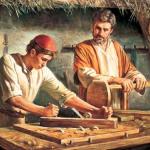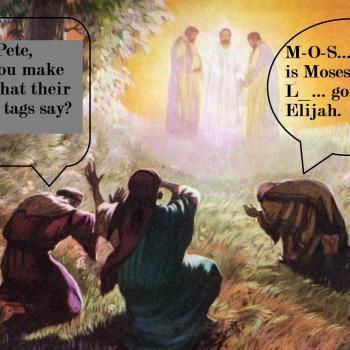I’ve been thinking about a couple of sayings of Jesus and the possibility that the one gave rise to the other for a while now. The two sayings are “come to me…take my yoke upon you” and “come after me…take up your cross.” When John Squires blogged about one of the two sayings, I decided it was time to share my thoughts with a wider audience:
Come to me, take my yoke, I will give you rest (Matt 11; Pentecost 6A)
There is a natural connection on the level of meaning between the sayings about taking Jesus’ yoke upon oneself and taking up one’s cross. To take a yoke is to commit to an endeavor, but more than that, it is to make oneself the property of an owner who can then drive you wherever they wish and use you for their purposes. To bear a yoke is to be a slave. Crucifixion is a punishment that Roman authors say was fit only for a slave. The classic depiction of Jesus on the Via Dolorosa (and of Simon of Cyrene when conscripted) involves being forced along a route one does not wish to travel, a cross-beam across one’s shoulders.
John Squires notes the connections with imagery used for Wisdom by Jesus ben Sira:
A hymn on the values of Wisdom concludes that book, with the invitation to “acquire wisdom for yourself … put your neck under her yoke and let your souls receive instruction” (Sir 51:25-26). Earlier in the book, this invitation to learn from Wisdom had been issued by Wisdom herself: “come to me, you who desire me, and eat your fill of my fruits” (Sir 24:19)…So many of these phrases resonate in the words attributed to Jesus in the book of origins (Matt 11:28-30). As he speaks, he claims the authority of Wisdom. His words provide insight, guidance, direction, as do the words of Wisdom in earlier Jewish traditions. Indeed, just a few verses earlier, the voice of Wisdom has been invoked by Jesus as he reflects on the criticisms he has received, as “a glutton and a drunkard, a friend of tax collectors and sinners” (11:19). The proof of the pudding is in the eating—“Wisdom is vindicated by her deeds”, is what Jesus responds.
Note also the connection with a famous prophetic action by Jeremiah. Jesus embodying Wisdom as prophet, engaging at times in symbolic actions of his own, made this imagery appropriate for him to draw on and apply to his own activity and that of his disciples. After the crucifixion, persuaded that Jesus must have known what would transpire and that it had been part of God’s plan all along, the disciples may have seen in the saying about taking up the yoke a prediction and a challenge related to taking up the cross. Jesus often spoke in veiled terms. They would have blamed their failure to grasp this deeper meaning on themselves.
Connecting this with a more general point, I find that I am less and less frequently concluding that things in our earliest sources are accurately described as “pure invention.” We need to allow for historical nuance that can have something be at once related to history and yet not (or not entirely) historical. When we do so, a great many things seem likely to be developments and transformations of things Jesus actually said and did, and even the purely symbolic stories often still reflect the impression that Jesus made as a historical figure. This point is one I’ll explore more fully in the introduction to What Jesus Learned From Women.
There is also some relevance of the sayings to our time, when many who claim to follow Jesus emphasize not self-sacrifice or servitude but self-reliance and success as understood by the world. Both the yoke saying and the cross saying connect with service and humble submission. Whether originally one which became the other or originally two separate sayings, and whether one or both is authentically from the historical Jesus, doesn’t necessarily have to detract from that point. But it may in the minds of some. Many wrestle with how matters of historical critical study relate to questions of the relevance and application of the teaching contained in the material.
Before concluding, let me say that I wonder whether this development from one saying to another has been proposed before. If not, perhaps it would be worth developing this into an article.













